A tale of the Kandyan royal architect and court intrigue
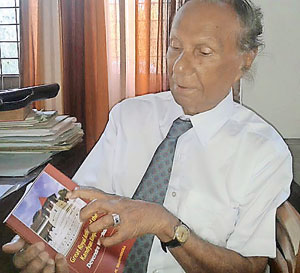
The author D.D. M. Waidyasekera
“Early in the morning, the spacious courts of the palace began to fill with headmen called mohottalas, corales, vidanes, generally speaking, men advanced in years of good and intelligent appearance with long black or grey beards. Many of them had never seen a European face, none or few of our military; their astonishment was great…it was a fine clear day… at four o’clock our friend Eheylepoola with the first and Adikars and all the Dessawe’s arrived with numerous retinues at the palace…” records Captain Macdowall de Bussche, in charge of the 8th Division of the British militia being privy to the ceding of the Kandyan Kingdom to the British on March 2, 1815.
Despite the ‘clear skies’ which prevailed as both de Bussche and John D’Oyly, the chief architect of the Convention and also the Chief Translator to the British Government confirms in his famous diary, the unbroken monarchial legacy of our island was snapped on this day 202 years ago.The decisive Convention which was actually signed on March 10, 1815 by the Kandyan chiefs, in a mix of Sinhala, Nagari and Grantha scripts and Governor Brownrigg on behalf of the British, was witnessed by John D’Oyly and James Sutherland, Deputy Secretary to the British Government.
The pillars which support the heavy beams and the ‘king-pest roof’ of the Magul Maduwa or the Audience Hall bear testimony to the tensions which prevailed in the hills as Kandyan sovereignty was vested in the British Crown and the last monarch of the island together with the Malabar race was excluded from the Throne.
The architectural masterpiece synonymous with the Kandyan Convention, complete with 32 carvings of Lakshmi, the Goddess of Wealth in its four corners holds in its bosom a chronicle little known.
D.D.M. Waidyasekera in his book, Great Royal Artificer of the Kandyan Kingdom- Devendra Mulachari, launched in Kandy yesterday (March 4) celebrates the master designer of the Kandyan Kingdom. Devendra Mulachari is also credited for some of the iconic historic monuments of the Kandyan Kingdom including the Pattirippuwa or Octagon of the Dalada Maligawa, Cloud Wall (walakulubemma) and the Kandy lake. “I was curious to discover the mastermind behind the Magul Maduwa. When I made casual inquiries from a few in the area, there were various accounts which drove me to do research on him,” recalled Mr. Waidyasekera.
A former Commissioner of Inland Revenue, Mr. Waidyasekera’s zest for history dates back to his undergraduate days at Peradeniya where he read the subject under illustrious dons such as Prof. W.J.C. Labrooy and Fr. Pinto. An author of several books on taxation and historical interest, Mr. Waidyasekera’s latest book, documenting the life and work of Devendra Mulachari is the fruit of nearly a decade of laborious research supported by the texts of reputed historians, sannasas, judicial proceedings of the Kandyan Board of Commissioners and personal visits to sites frequented by the great artificer and his descendants. Historian Prof. K.D. Paranavitana notes in the Foreword that the author ‘has attempted to make a link with all possible known descendants of Devendra Mulachari’.
The title ‘Mulachari’ was given to an artificer who was an expert in at least five arts and crafts. As John D’Oyly had observed, there were seven artificers under one Mulachari and it was a coveted position; Adigars could not inflict corporal punishment on them, nor could they be fined or imprisoned without the King’s authority. The ancestry of Devendra Mulachari and his exact place of birth according to Mr. Waidyasekera is not clear. “However it could be assumed that he was born probably around 1747 during the reign of King Kirti Sri Rajasinha and had served under three monarchs- Kirti Sri Rajasinha, Rajadi Rajasinha and the last king of the nation, Sri Wickrema Rajasinha,” he explains.
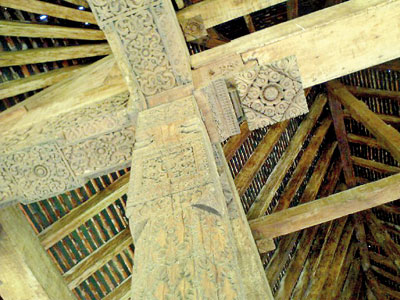
Intricate carvings on the pillars of the Magul Maduwa
According to Lawrie’s Gazetteer, Devendra Mulachari’s first architectural work was the construction of the Bana Maduwa in Middeniya. The place which was used as a meeting place for official and unofficial purposes and also as a preaching hall had been demolished around 2004 as Mr. Waidyasekera notes and was replaced by a Samurdhi meeting place today. This was followed by a series of designs including Pattirippuwa which H.W. Cave in his ‘The Book of Ceylon’ describes as the ‘most conspicuous building in Kandy and perhaps the most striking.’ The master designer is also credited with the construction of the Kandy Lake and the Diyarella bemma skirting it. He is also associated with the Degaldoruwa Cave Temple.
The historical Magul Maduwa was commissioned by King Rajadhi Rajasinha in 1784 and the architecture and the carvings of it were assigned to Devendra Mulachari. Supported by 64 elaborately carved columns adorned with authentic Kandyan designs, its four corners are embellished with 32 carvings of Goddess Lakshmi. As documented by Mr. Waidyasekera, ‘there were seven curtains hung inside and the king could only be seen after passing through all seven.’ The timber used in construction which consisted of halmilla, na and teak was brought from Nalanda off Matale.
Magul Maduwa played a pivotal judicial and a diplomacy role both during the Kandyan kings and in the early British period. The Mahanadu or the highest court proceedings preceded by the king were heard there. It was also the place where royal grants and decrees were conferred to high officials. It also became a meeting place for foreign ambassadors and other special guests. It was at Magul Maduwa the kapuralas of the four Devales met to report to the king the successful completion of the Kandy Esala Perahera.
The architect of this iconic structure which was privy to many a spectacle in history (historical events?) did not live to see his masterpiece being completed. As J.P. Lewis records in The Book of Ceylonby H.W. Cave, ‘the building was begun in 1784 by Rajadhi Rajasinha but was not completed until after the British occupation. The pillars were still being carved about 1820.’ While the construction of Magul Maduwa was on, Devendra Mulachari became the victim of the intrigues of the Kandyan Court. Both Coomaraswamy and Codrington in their work note that the Kandyan chiefs who furnished the timber for the Magul Maduwa falsely complained to King Sri Wickrema Rajasinha that the Mulachari shortened the beams brought and rejected them. “It is believed that most royal officials of the court were jealous of Mulachari as he was very close to the king. He also resembled the king in features and build and this may have been another reason which kindled jealousy and hostility towards him among the Adigars,” observes Mr. Waidyasekera.
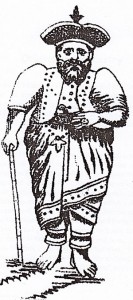
The Paththirippuwa and walakulu bemma
The king is said to have threatened to cut off Devendra Mulachari’s finger (plural or singular?) upon hearing the tales of the Adigars. The Royal architect who could not compromise his integrity took his own life in 1812 by drowning himself in the very lake he designed.
“However in certain quarters it is believed that there was no such threat but the conspirators made Mulachari believe it to be so. It is said that the King having noticed a headgear floating in the Kandy Lake learnt of the tragedy and was in great remorse and distress having lost his favourite artificer in such a tragic manner,” reflects the author who further says that Mulachari was given a funeral with royal honours. “It is said that in honour of the royal architect the King erected a plaque in the small island in the middle of the lake. The plaque however is no longer there.”
After the tragic death of Devendra Mulachari, the man who realized a celestial existence for the last three monarchs of the island, (??) his wife and children (two sons and a daughter) had lived incognito in Embekke for quite sometime. In a strange twist of fate, four years after Devendra Mulachari’s tragic end, in 1816 his eldest son Devasinha Mulachari died in the same manner “having drowned himself in the Lake of Kandy” in the words of the Judicial Commissioner’s Court Proceedings, Kandy, 18th February 1824.
While only a flight of stone steps leading to the house and a fresh water deep well remain in what is left of Devendra Mulachari’s garden, his cubit measure or riyandanda which was an integral part of his work is preserved in the Kandy Museum today, bearing many more untold tales…
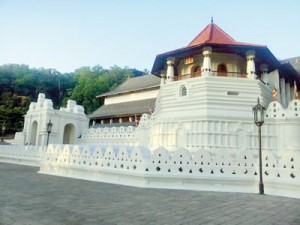
The Paththirippuwa and walakulu bemma
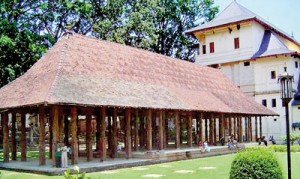
The Magul Maduwa as it stands today. (Pix courtesy ‘Great Royal Artificer of the Kandyan Kingdom- DevendraMulachari, Google Images)


